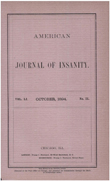Psychodynamics and psychiatric diagnoses of pseudoseizure subjects
Abstract
OBJECTIVE: The goal of this study was to determine current and lifetime rates of DSM-III-R disorders in patients with pseudoseizures and to ascertain whether trauma is associated with the occurrence of pseudoseizures. METHODS: Adult pseudoseizure patients (N = 45) were interviewed regarding seizure course and life events, and they were given the Structured Clinical Interview for DSM-III-R--Patient Version, the Structured Clinical Interview for DSM-III-R Dissociative Disorders, the Dissociative Experiences Scale, and the Personality Diagnostic Questionnaire--Revised. The pseudoseizures were diagnosed in a tertiary- care video-EEG facility. Most of the subjects (78%) were female, and the mean age of the overall patient group was 37.5 years (SD = 9.7). RESULTS: The mean duration of the subjects' seizure history was 8.3 years (SD = 8.0). Common current psychiatric diagnoses included somatoform disorders (89%), dissociative disorders (91%), affective disorders (64%), personality disorders (62%), posttraumatic stress disorder (PTSD) (49%), and other anxiety disorders (47%). The lifetime occurrence of nonseizure conversion disorders was 82%. The mean Dissociative Experiences Scale score was 20.2 (SD = 18.2). Trauma was reported by 84% of the subjects: sexual abuse by 67%, physical abuse by 67%, and other traumas by 73%. CONCLUSIONS: Pseudoseizure subjects have high rates of the psychiatric disorders found in traumatized groups; they closely resemble patients with dissociative disorders. Reclassification of conversion seizures with the dissociative disorders should be considered. Pseudoseizures often appear to express distress related to abuse reports. Clinicians should screen pseudoseizure patients for adult and childhood trauma, dissociative disorders, depression, and PTSD.
Access content
To read the fulltext, please use one of the options below to sign in or purchase access.- Personal login
- Institutional Login
- Sign in via OpenAthens
- Register for access
-
Please login/register if you wish to pair your device and check access availability.
Not a subscriber?
PsychiatryOnline subscription options offer access to the DSM-5 library, books, journals, CME, and patient resources. This all-in-one virtual library provides psychiatrists and mental health professionals with key resources for diagnosis, treatment, research, and professional development.
Need more help? PsychiatryOnline Customer Service may be reached by emailing [email protected] or by calling 800-368-5777 (in the U.S.) or 703-907-7322 (outside the U.S.).



